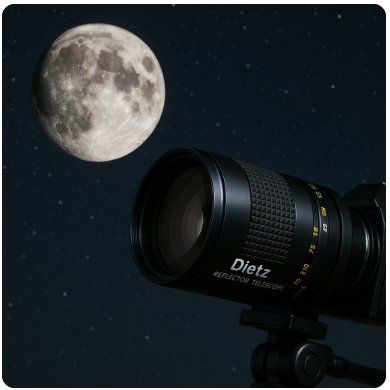Introduction
The idea of using a Dietz reflector telescope as a camera lens may sound unusual, but it opens the door to a fascinating realm of experimentation and creativity. Whether you’re a vintage optics enthusiast, amateur astronomer, or creative photographer, learning how a Dietz reflector telescope camera lens works can be both educational and exciting. In this article, we’ll explore how this setup functions, what benefits and challenges it brings, and how you can make the most of it.
History of Dietz Reflectors
The Dietz brand is widely known for its historical lanterns and lighting products, especially kerosene and automobile lamps from the late 1800s to the mid-1900s. Interestingly, the reflectors from some of these lighting products found secondary use in optical devices, such as telescopes and primitive camera setups.
Though not initially intended for photography, these reflectors possess mirror-like surfaces that can focus light—a basic principle in all telescopic lenses. Over time, hobbyists began adapting these parts to build or modify reflector telescopes, and eventually, they were used as makeshift camera lenses.
Optical Fundamentals
Reflector telescopes, including ones built from or inspired by Dietz reflectors, use curved mirrors to collect and focus light. The typical configuration is the Newtonian design, which includes a primary concave mirror and a smaller flat secondary mirror.
Light reflects off the primary, bounces off the secondary, and exits through a side eyepiece. In a camera setup, the eyepiece is replaced with a T-adapter or direct camera mount, converting the telescope into a telephoto lens.
However, unlike modern camera lenses, reflector telescopes like the Dietz-based setup do not have lens elements to correct for image distortions such as chromatic aberration or field curvature. This means while the center of the image may be sharp, edges can be blurred or warped.
Mounting a Camera
Attaching a camera to a Dietz reflector telescope requires a few essential tools. Most commonly, you’ll need a T-ring specific to your camera model and a telescope camera adapter. The camera can be mounted in two main ways:
- Prime-Focus Photography: The telescope acts as the lens itself. You remove the eyepiece and attach your camera directly. This is best for astrophotography and very distant objects.
- Eyepiece Projection: Here, the camera captures an image through the eyepiece of the telescope. This is useful for closer terrestrial photography but may require more focusing adjustments.
The right combination of adapters, spacers, and a sturdy tripod ensures that your camera remains stable and aligned correctly.
Image Quality and Aberrations
When using a Dietz reflector telescope camera lens, image quality is both its charm and its challenge. You can achieve a natural, raw visual feel with this method, but you’ll also face several optical imperfections. These include:
- Coma: Stars or bright lights may appear to have tails near the image edges.
- Field Curvature: The outer parts of the image may be out of focus while the center remains sharp.
- Chromatic Aberration: Colors may separate or fringe, especially near contrasting edges.
These effects are not always undesirable. Some photographers find them creatively useful for achieving a dreamy or vintage aesthetic.
Focusing and Usability Tips
Using a Dietz reflector telescope as a camera lens involves a different focusing experience compared to regular lenses. Manual focus is the only option, and due to the narrow depth of field, precision is key. Infinity focus may require additional adapters or adjustment of the primary mirror’s position.
Keep in mind that atmospheric conditions affect long-distance clarity. Heat waves, air pollution, and humidity can distort your shot. Also, reflector telescopes naturally invert images vertically and horizontally. For correct orientation, you can add an erecting prism or use editing software later.
Practical Setup Guide
Here’s a basic setup guide for turning your Dietz reflector telescope into a camera lens:
| Step | Action Description |
|---|---|
| 1 | Choose your Dietz reflector telescope |
| 2 | Detach the eyepiece section |
| 3 | Attach T-ring and adapter to your camera body |
| 4 | Connect camera to the telescope focus tube |
| 5 | Balance the setup on a sturdy tripod |
| 6 | Manually adjust focus while viewing live feed |
This process requires patience, especially during the focusing phase. Practice and experimentation go a long way.
Pros and Cons
Let’s examine the strengths and weaknesses of using a Dietz reflector telescope camera lens.
| Pros | Cons |
| Cost-effective for long focal lengths | Lacks image correction lenses |
| Fun and educational to experiment | Inverted images unless corrected |
| Suitable for astronomy photos | Limited usability in general photography |
| Vintage look with creative output | Manual focus only, no aperture control |
Comparative Options
Before you commit to using a reflector telescope, you might want to explore other options. Camera manufacturers offer telephoto lenses and mirror lenses designed for long-distance photography. These include catadioptric lenses, which combine mirrors and lenses to correct distortions while maintaining compact size. While more expensive, these provide sharper, better-balanced images.
Still, if you’re on a budget or simply love DIY optics, the Dietz reflector telescope camera lens remains a fun and viable option.
Use Cases and Results
This type of lens setup is best suited for:
- Photographing the moon or planets
- Capturing distant wildlife or mountain scenes
- Creating experimental art-style images with bokeh distortion
Many users report soft central sharpness with a circular vignette effect around the frame—ideal for those seeking retro or analog visual styles.
Troubleshooting
Here are some common issues and their solutions:
- Can’t Reach Focus: Add extension tubes or reposition the primary mirror.
- Blurry Edges: Accept them as part of the aesthetic or crop the image.
- Image Inversion: Use software flipping or attach a correcting prism.
- Camera Vibration: Use a remote shutter release or timer delay.
Enhancements and Mods
With a bit of customization, you can upgrade your Dietz reflector setup:
- Add a Barlow lens to increase magnification.
- Use a Schmidt corrector plate to reduce coma and field curvature.
- Modify the focuser tube for better alignment with DSLR cameras.
These tweaks help improve overall performance while retaining the telescope’s charm.
Conclusion
Using a Dietz reflector telescope camera lens is a unique journey into vintage optics and creative photography. While it may not match the precision of modern lenses, its affordability and character make it a worthwhile experiment for tinkerers and visual storytellers alike. If you’re looking to explore new photographic techniques, give the Dietz reflector a try—you might be surprised by the results.
Further Reading and Resources
For those who want to dig deeper:
- Reddit Photography and Astronomy Threads
- Telescope Adapters & Accessory Kits
- YouTube DIY Tutorials on Telescope Photography
- Articles on Reflector Optics and Mirror-Based Lens Design
Related Articles
Complete Guide to OLED Software for Azith: Customize Your ASUS ROG Azoth Keyboard Display
How to Download eFootball 2024 on Laptop Using Usitility (Code: aslqecqc1fe)
Can Rumtuk Laptops Run Adobe Software? Full Guide for Creative Users

